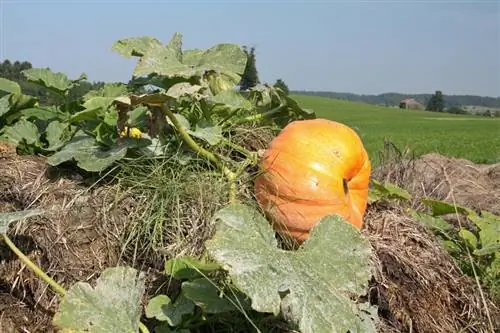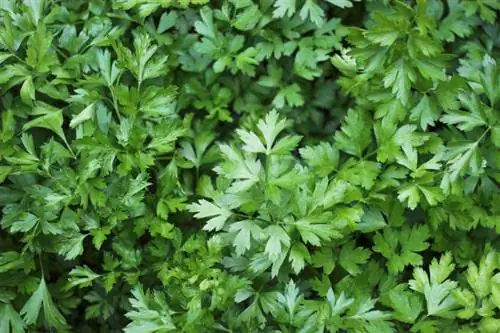- Author admin [email protected].
- Public 2023-12-16 16:46.
- Last modified 2025-06-01 06:02.
Don't be fooled by the few care aspects of a pumpkin culture. Every single factor is extremely relevant. This is how you care for the pumpkin appropriately.

How do you properly care for pumpkins?
For species-appropriate pumpkin care, water moderately and regularly, fertilize with organic material such as compost and decide whether you want to maximize fruit. Protect plants from diseases such as mildew and pests such as snails.
When to water a pumpkin?
Water pumpkin plants moderately but regularly. Drought always causes growth to stop. Water immediately onto the root area. Wet leaves and damp flowers are always at risk of disease.
How to fertilize a pumpkin?
A constant supply of nutrients is considered a mainstay in pumpkin care. Since chemical preparations are viewed critically in hobby gardens, organic fertilizers dominated. The undisputed leader is well-ripened garden compost, which you apply every 14 days. In addition, plant manure, guano, horse manure and horn shavings provide nitrogen, potassium and phosphorus.
Simply or not? - You decide
If you let your pumpkin plants grow freely, the harvest will produce a variety of small fruits. This can certainly be in the gardener's interest. The plant will not develop a large pumpkin, even one with the potential to become a giant, without your help. In this case, leave only as many flowers as you want pumpkins. Avoid all other female and male flowers.
- basically maximizing the first flowering increases the growth power of the plant
- in June from a leaf count of 3-5, shorten each tendril down to 2 leaves
- In July, cut back all shoots so that the last fruit is still supplied with two leaves
Are there any threatening diseases and pests?
The fungal infection mildew is visually revealed by a white-grey spore lawn on the leaves. How to fight the plant disease:
- remove affected leaves immediately
- Interrupt administration of nitrogen fertilizer
- spray repeatedly with a solution of 1 liter of water, 15 milliliters each of soft soap and spirit
- alternatively, dissolve a heaped tablespoon of soda in 4 liters of water and spray regularly
Among the pests, it is - no surprise - the voracious slugs that prefer to target pumpkin plants. How to protect the bed from baldness:
- Installing mobile barriers made of chips, sharp-edged chippings or coarse sand
- surround the bed with a snail fence and place a beer trap
- sprinkle the coffee grounds that are toxic to snails
- tirelessly collecting the cold animals every morning with the snail tongs
Tips & Tricks
A pumpkin also suffers from the blazing summer sun. Instead of sunburn, cracks form on the shell. Since spots of rot can form here and diseases can strike, treat this gem to sun protection. Covered with a damp cloth, the sun's rays can no longer harm the fruit.






